|
|
 |
Fiche d'espèce de Copépode |
|
|
Calanoida ( Ordre ) |
|
|
|
Clausocalanoidea ( Superfamille ) |
|
|
|
Aetideidae ( Famille ) |
|
|
|
Bradyidius ( Genre ) |
|
|
| |
Bradyidius plinioi Campaner, 1978 (F,M) | |
| | | | | | | Syn.: | Bradyidius plinioi plinioi & B. plinioi minor Campaner, 1978 (p.865, figs.F, juv.M, p.871, Descr.F, figs.F). | | | | Ref.: | | | Björnberg & al., 1981 (p.605, 630, figs.F); Alvarez, 1984 (p.94, Descr.M, figs.M, Rem.: p.96); Othman & Greenwood, 1987 (p.1137, Rem.); Bradford-Grieve & al., 1999 (p.879, 918, figs.F, as plinoi) | 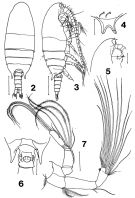 issued from : A.F. Campaner in Ciência e Cultura, 1978, 30 (7). [p.866, Figs. 2-7]. As Bradyidius plinoi plinoi. Female (from continental shelf, Brazil): 2, habitus (dorsal); 3, idem (lateral right side); 4, rostrum (frontal ciew); 5, forehead (lateral); ; 6, last thoracic segment and genital segment (ventral); 7, A2. Scale bars: 0.500 mm (2, 3); 0.200 mm (5); 0.100 mm (6, 7); 0.050 mm (4). Nota: Head and 1st thoracic segment separate (with a very thin suture).
|
 issued from : A.F. Campaner in Ciência e Cultura, 1978, 30 (7). [p.867, Figs. 8-14). As Bradyidius plinoi plinoi. Female: 8, A1; 9, Md (mandibular palp); 10, Md (cutting edge); 11, Mx1; 12, 3rd inner lobe of Mx1; 13, 1st inner lobe of Mx1 (dorsal); 14, idem (ventral). Scale bars: 0.500 mm (8); 0.100 mm (9, 11); 0.050 mm (10, 12-14).
|
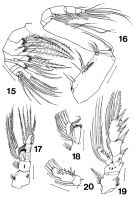 issued from : A.F. Campaner in Ciência e Cultura, 1978, 30 (7). [p.868, Figs.15-19). As Bradyidius plinoi plinoi. Female: 15, Mx2; 16, Mxp; 17, P1; 18, endopodite of P1; 19, P2; 20, endopodite of P2. Scale bars: 0.100 mm. Nota: Occurrence of a group of large spines on endopodite 2 of P2.
|
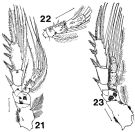 issued from : A.F. Campaner in Ciência e Cultura, 1978, 30 (7). [p.869, Figs. 21-23). As Bradyidius plinoi plinoi. Female: 21, P3; 22, endopodite of P3; 23, P4. Scale bars: 0.100 mm (21-23). Scale bars: 0.100 mm (21-23). Nota: Occurrence of a group of large spines on endopodite 2 of P3.
|
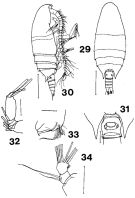 issued from : A.F. Campaner in Ciência e Cultura, 1978, 30 (7). [p.867, Figs. 29-34). As Bradyidius plinoi minor. Female: 29, habitus (dorsal); 30, idem (lateral right side); ; 31, postero-lateral corners of last thoracic segment and genital segment (ventral); 32, exopodite of A2 (partial); 33, terminal part of 1st basipodite of Mxp; 34, Md (exopodite). Scale bars: 0.500 mm (29-30; 0.050 (31-34).
|
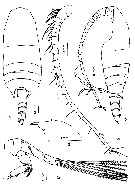 Issued from : M.A. Jimenez Alvarez inBolm. Zool. Univ,. S. Paulo, 1984, 8. [p.95, Figs.1-5] Male (28°36'S, 47°55'W): 1-2, habitus (dorsal and lateral, respectively); 3, forehead with rostrum (lateral); 4, A1; 5, A2. Nota: Cephalon and 1stpedigerous segment partially fused (dorsal visible suture almost complete, 4th and 5th thoracic segments almost completely fusd, ending in potero-lateral projections, acutely pointed and slightly asymmetrical ; the left, a little longer, overreaches the posterior margin of genital segment. Urosome 5-segmented. Proportional length of segments and caudal rami 21.7 : 20.0 : 16.7 : 15.0 : 26.7 = 100. Genital segment slightly asymmetrical. Anal sefment wery reduced and only ventrally visible. Caudal rami with 1 short lateral seta and 3 terminal setae. Left A1 24-segmented, reaching the caudal rami ; segments bearing thick sensory setae up to 13th segment included, and, the thinner ones up to the end and other very thin setules. Right A1 lost. A2 2nd basipod with 2 setae ; exopod and endopod almost equal in length ; 2nd endopodal segment with 5 subterminal and 4 terminal setae on the lateral margin ; externally there is a group of very small spines.
|
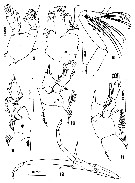 Issued from : M.A. Jimenez Alvarez inBolm. Zool. Univ,. S. Paulo, 1984, 8. [p.103, Figs.6-12] Male; 6, Md (palp); 7, Mx1; 8, Mxp; 9, P1; 10, P2; 11, P3; 12, P5. Mandibular palp with well developed basipod and 1 internal marginal seta. The two-segmented endopod is short. The exopod has 1 long thick seta on each of its four first segments, the last has 2 setae. The gnathobase was not found in this specimen. Mx1 reduced with 3 setae on the 1st external lobe, 9 setae on the exopod ; no setae on the 1st internal lobe, 2setae on the other internal lobe and 6 fine setae plus a very long one on the fused 2nd basipod and endopod. 1st basipod of Mxp without setae ; 2nd basipodal segment with 2 long plumose setae and 1 very shot.. The 1st to 5th endopodal segments bear respectively 5 : 3 : 4 : 3 : 4 setae. P5 asymmetrical and very big. Left leg, shorter than the right with the basipods and the 3 segments of the exopod long, the last segment the shortest and bearing some setae ; endopod reduced, 1-segmented in both legs.. The 1st segment of the exopod of the right leg is much longer than the second, and this is curved with a bulge on the lateral internal margin.
| | | | | Ref. compl.: | | | Markhaseva, 1998 (p.250, Fig.2) | | | | NZ: | 1 | | |
|
Carte de distribution de Bradyidius plinioi par zones géographiques
|
| | | | Loc: | | | S Brazil | | | | N: | 3 | | | | Lg.: | | | (218) F: 2,52-2,45 (plinioi plinioi); 1,95-1,85 (plinioi minor); (217) M: 1,5; {F: 1,85-2,52; M: 1,50} | | | | Rem.: | hyperbenthique
Voir aussi les remarques en anglais | | | Dernière mise à jour : 30/12/2014 | |
|
|
 Toute utilisation de ce site pour une publication sera mentionnée avec la référence suivante : Toute utilisation de ce site pour une publication sera mentionnée avec la référence suivante :
Razouls C., Desreumaux N., Kouwenberg J. et de Bovée F., 2005-2025. - Biodiversité des Copépodes planctoniques marins (morphologie, répartition géographique et données biologiques). Sorbonne Université, CNRS. Disponible sur http://copepodes.obs-banyuls.fr [Accédé le 26 décembre 2025] © copyright 2005-2025 Sorbonne Université, CNRS
|
|
 |
 |










